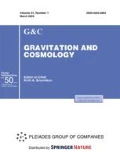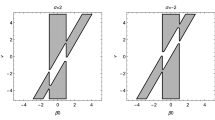Abstract
We use the canonical formalism of classical mechanics together with the first law of thermodynamics to unveil a differential equation for a minimally coupled canonical scalar field which should be solved simultaneously with the Klein–Gordon equation. This equation was obtained by realizing that the thermodynamic work is equal to the work done by the generalized force to increase the scalar field by an amount \(d\phi\). Then, using the first law of thermodynamics, we obtain the equation \({\dot{\phi}}(dV/d\phi)={-}3H[{\dot{\phi}}^{2}/2-V(\phi)]\) which, together with the Klein–Gordon equation, rules the dynamics of this minimally coupled scalar field. We demonstrate precisely that the potential \(V\), that satisfies both equations simultaneously, evolves with the scale factor as \(V\propto a^{-3\sqrt{2}}\) and dominated the early stages of the Universe expansion history. We carry out an observational analysis together with some of the most updated data currently available, and we prove that the energy density of this field is comparable to the radiation density energy at redshifts of order \(10^{8}\), which is nearly 100 times smaller than the radiation energy density today. Although negligible today, we have shown that this scalar field can alleviate enormously the so-called \(H_{0}\) tension.


Similar content being viewed by others
Notes
The convention used here is that Greek indices runs from 0 to 3 and Latin indices run from 1 to 3.
The use of these cosmological probes in a joint analysis is useful to brake the degenerescence between the model parameters.
REFERENCES
A. G. Reiss et al., Astron. J. 116, 1009 (1998).
S. J. Perlmutter et al., Astrophys. J. 517, 565 (1999).
D. N. Spergel et al., Astrophys. J. Suppl. 148, 175 (2003).
D. J. Eisenstein et al., Astrophys. J. 633, 560 (2005).
S. Weinberg, Rev. Mod. Phys. 61, 1 (1989).
T. Padamanbhan, Class. Quantum Grav. 19 L167 (2002);
T. Padamanbhan, Class. Quantum Grav. 19 L167 (2002); T. Padamanbhan, Phys. Rep. 380, 235 (2003).
R. Bousso, Gen. Rel. Grav. 40, 607 (2008).
V. Emelyanov and F. R. Klinkhamer, Phys. Rev. D 85, 103508 (2012).
D. J. Shaw and J. D. Barrow, Phys. Rev. D 83, 043518 (2011);
D. J. Shaw and J. D. Barrow, Phys. Rev. D 83, 043518 (2011); J. D. Barrow and D. J. Shaw, Phys. Rev. Lett. 106, 101302 (2011).
S. Aslanbeigi et al., Phys. Rev. D 84, 103522 (2011).
P. D. Mannheim, Gen. Rel. Grav. 43, 703 (2011).
A. Linde and V. Vanchurin, “Towards a non-anthropic solution to the cosmological constant problem,” arXiv:1011.0119.
H. Stefancic, Phys. Lett. B 670, 246 (2009).
J. Garriga and A. Vilenkin, Phys. Rev. D 64, 023517 (2001).
S. M. Carroll and G. N. Remmen, Phys. Rev. D 95, 123504 (2017).
S. Viaggiu, Class. Quantum Grav. 35, 215011 (2018).
C. Wetterich, Nucl. Phys. B 302, 668 (1988);
B. Ratra and P. J. E. Peebles, Phys. Rev. D 37, 3406 (1988);
R. R. Caldwell, R. Dave, and P. J. Steinhardt, Phys. Rev. Lett. 80, 1582 (1998);
C. Wetterich, Nucl. Phys. B 302, 668 (1988); B. Ratra and P. J. E. Peebles, Phys. Rev. D 37, 3406 (1988); R. R. Caldwell, R. Dave, and P. J. Steinhardt, Phys. Rev. Lett. 80, 1582 (1998); R. R. Caldwell, Braz. J. Phys. 30, 215 (2000).
E. M. Barboza Jr., R. C. Nunes, E. M. C. Abreu, and J. A. Neto, Phys. Rev. D 92, 083526 (2015).
R. C. Duarte, E. M. Barboza Jr., E. M. C. Abreu, and J. A. Neto, Eur. Phys. J. C 79, 356 (2019).
J. H. Lane, Am. J. Sci. Arts 50, 57 (1870).
A. M. Oztas, E. Dil and M. L. Smith, “Adiabatic expansion Universe with varying cosmological constant: Models tested with observational data,” arXiv: 1801.05033.
I. Prigogine, J. Geheniace, E. Gunzig, and P. Nardone, Proc. Nat. Acad. Sci. 85, 7428 (1988).
A. Iqbal and A. Jawad, Int. J. Geom. Meth. Mod. Phys. 10, 1950081 (2019);
G. Cognola, Phys. Rev. D 57, 6292 (1998);
A. Iqbal and A. Jawad, Int. J. Geom. Meth. Mod. Phys. 10, 1950081 (2019); G. Cognola, Phys. Rev. D 57, 6292 (1998); M. D. Pollock, Nucl. Phys. B 208, 182 (1982).
R. I. Ivanov and E. M. Prodanov, Eur. Phys. J. C 79, 118 (2019) and references therein.
M. Betoule et al., Astron. Astrophys. 568, A22 (2014).
D. Eisenstein and W. Hu, Astrophys. J. 496, 605 (1998).
F. Beutler et al., MNRAS 416, 3017 (2011).
L. Anderson et al., MNRAS 427, 3435 (2012).
W. J. Percival et al., MNRAS 401, 2140 (2010).
C. Blake et al., MNRAS 418, 1707 (2011).
W. Hu and N. Sugiyama, Astrophys. J. 471, 542 (1996).
L. Chen, Q.-G. Huang, and K. Wang, “Distance Priors from Planck Final Release,” arXiv: 1808.05724.
N. Aghanim et al. [Planck Collaboration], arXiv:1807.06209.
R. Jimenez and A. Loeb, Astrophys. J. 573, 37 (2002).
J. Simon, L. Verde, and R. Jimenez, Phys. Rev. D 71, 123001 (2005).
D. Stern, R. Jimenez, L. Verde, S. A. Stanford, and M. Kamionkowski, Astrophys. J. Suppl. 188, 280 (2010).
M. Moresco et al., JCAP 08, 006 (2012).
C. Zhang, H. Zhang, S. Yuan, S. Liu, T.-J. Zhang, and Y.-C. Sun, Res. Astron. Astrophys. 14, 1221 (2014)
M. Moresco, MNRAS 450, L16 (2015).
M. Moresco et al., JCAP 05, 014 (2016).
A. L. Ratsimbazafy et al., MNRAS 467, 3239 (2017).
A. Riess et al., Astrophys. J. 861, 126 (2018).
Q.-G. Huang and K. Wang, EJPC 76, 506 (2016).
R.-Y. Guo, J.-F. Zhang, and X. Zhang, “Can the \(H_{o}\) tension be resolved in extensions to \(\Lambda\)CDM cosmology?,” arXiv: 1809.02340.
N. Sugiura, “Further analysis of the data by Akaikes information criterion and the finite corrections,” Communications in Statistics—Theory and Methods A 7, 13 (1978).
G. Schwarz, Ann. Statist. 6, 461 (1978).
D. J. E. Marsh, Phys. Rep. 643, 1 (2016).
P. S. Sikivie, Lect. Notes Phys. 741, 19 (2008).
G. G. Raffelt, Lect. Notes Phys. 741, 51 (2008).
A. D. Linde, Phys. Lett. B 259, 38 (1991).
S. D. Odintsov and V. K. Oikonomou, Euro Phys. Lett. 129, 40001 (2020).
S. D. Odintsov and V. K. Oikonomou, Phys. Rev. D 101, 044009 (2020).
S. D. Odintsov and V. K. Oikonomou, Phys. Rev. D 99, 104070 (2019).
S. D. Odintsov and V. K. Oikonomou, Phys. Rev. D 99, 064049 (2019).
Funding
E.M.C.A. is the corresponding author. This research was financially supported in part by the Coordenaзão de Aperfeiзoamento de Pessoal de Nível Superior—Brasil (CAPES)—Finance Code 001. E.M.C.A. and J.A.N. thank CNPq, Conselho Nacional de Desenvolvimento Científico e Tecnológico, for partial financial support, Grants number 406894/2018-3 (E.M.C.A.) and 303140/2017-8 (J.A.N.). CAPES and CNPq are Brazilian scientific support federal agencies.
Author information
Authors and Affiliations
Corresponding authors
Rights and permissions
About this article
Cite this article
Abreu, E.M., Barboza Jr., E.M. & Neto, J.A. A New Equation for a Scalar Field from Thermodynamics First Law and Its Cosmological Implications. Gravit. Cosmol. 27, 1–10 (2021). https://doi.org/10.1134/S0202289321010023
Received:
Revised:
Accepted:
Published:
Issue Date:
DOI: https://doi.org/10.1134/S0202289321010023



